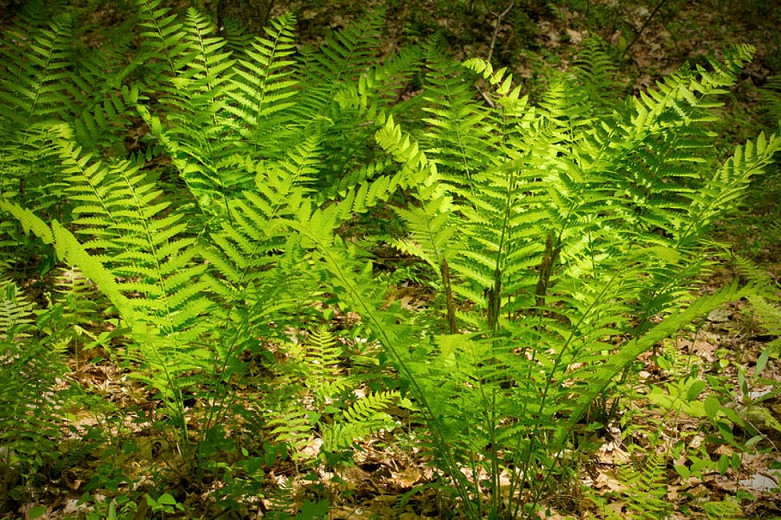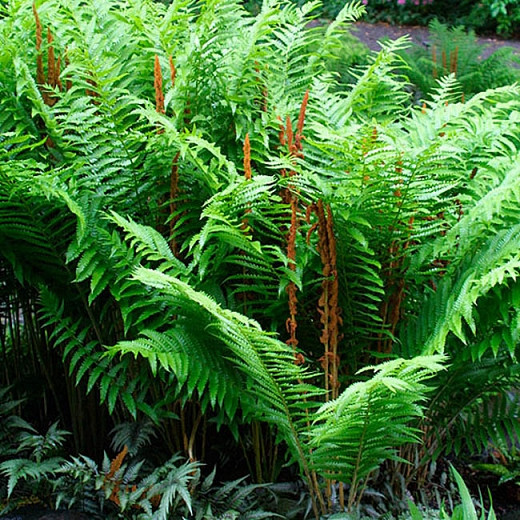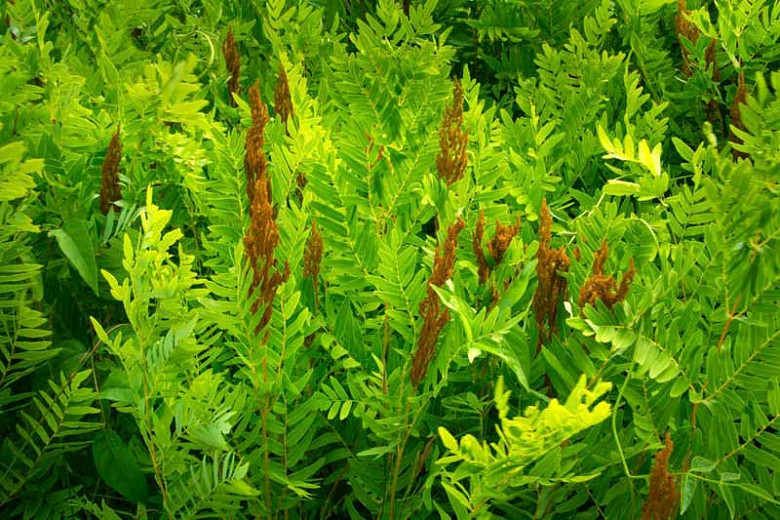Osmunda claytoniana (Interrupted Fern)
A very interesting plant for the shady garden, Osmunda claytoniana (Interrupted Fern) is a charming deciduous fern with showy, lance-shaped, divided, pale green sterile fronds surrounding erect, central fertile fronds. The fertile fronds are interrupted in the middle by brown leaflets (spore-bearing pinnae) which typically fall off in mid-summer, thus giving this distinctive fern its common name. The interrupted Fern is one of the first ferns to begin growth in spring.
A very interesting plant for the shady garden, Osmunda claytoniana (Interrupted Fern) is a charming deciduous fern with showy, lance-shaped, divided, pale green sterile fronds surrounding erect, central fertile fronds. The fertile fronds are interrupted in the middle by brown leaflets (spore-bearing pinnae) which typically fall off in mid-summer, thus giving this distinctive fern its common name. The interrupted Fern is one of the first ferns to begin growth in spring. The oldest known fossil record of any living fern in the world is over 200 million years old!
Low maintenance, pest, and disease-free, Interrupted Fern is a great asset for very wet sites!
- Clump-forming, it easily grows in a spreading-vase shape, up to 2-3 ft. tall and wide (60-90 cm). May reach up to 5 ft. (150 cm) if even moisture is provided.
- A part shade to full shade lover, it is best grown in rich, consistently moist, acidic, well-drained soils. Do not allow the soil to dry out. Will grow in full sun if given plenty of moisture.
- This plant is a great choice for shady beds, borders, underplanting of roses and shrubs, cottage gardens, woodlands, bog gardens, or along streams, ponds, or water gardens. Combines beautifully with Azaleas, Astilbes, Hostas, or Primulas.
- Rabbit, deer, clay & wet soil tolerant!
- Dead or damaged fronds may be removed as necessary.
- Propagate by sowing spores as soon as ripe or by division in early spring or autumn
- Native to Eastern Asia, Eastern United States, and Eastern Canada.
Requirements
| Hardiness | 3 – 8 |
|---|---|
| Heat Zones | 1 – 9 |
| Plant Type | Ferns |
| Plant Family | Osmunda – Ferns |
| Exposure | Partial Sun, Shade |
| Season of Interest | Spring (Mid,Late)Summer (Early,Mid,Late)Fall |
| Height | 2' – 3' (60cm – 90cm) |
| Spread | 2' – 3' (60cm – 90cm) |
| Spacing | 36″ (90cm) |
| Water Needs | Average, High |
| Maintenance | Low |
| Soil Type | Clay, Loam, Sand |
| Soil pH | Acid |
| Soil Drainage | Moist but Well-Drained, Poorly Drained |
| Characteristics | Showy |
| Native Plants | United States, Midwest, Illinois, Indiana, Iowa, Michigan, Minnesota, Missouri, Ohio, Wisconsin, Northeast, Connecticut, Delaware, Maine, Massachusetts, Maryland, New Hampshire, New Jersey, New York, Pennsylvania, Rhode Island, Vermont, Southeast, Alabama, Arkansas, Georgia, Kentucky, Mississippi, North Carolina, South Carolina, Virginia, West Virginia |
| Tolerance | Clay Soil, Deer, Rabbit, Wet Soil |
| Garden Uses | Beds and Borders, Bog Gardens, Ponds and Streams, Underplanting Roses and Shrubs |
| Garden Styles | City and Courtyard, Informal and Cottage, Prairie and Meadow, Traditional Garden |



